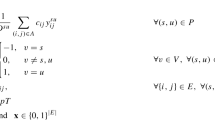Abstract
A branch vertex is a vertex with degree larger than or equal to three. This paper addresses two spanning tree problems in an undirected, simple graph. The first one is to find a spanning tree that minimizes the number of branch vertices (MBV), and the second one is to find a spanning tree that minimizes the degree sum of branch vertices (MDS). These two problems arise in the design of wavelength-division networks (WDN), when the cost of equipments for enabling multicast communication is to be minimized. After investigating the relations of MBV and MDS with the problem of minimizing the number of leaves in a spanning tree, new formulations based on ILP are proposed for MBV and MDS, along with two cutting plane algorithms for addressing them. A repair function is also introduced for deriving feasible solutions from the candidate trees returned at each iteration of the cutting plane algorithm, as well as a Tabu search procedure for further quality improvement. The resulting hybrid approach is shown to outperform pure ILP formulations and heuristic approaches published earlier.














Similar content being viewed by others
References
Arora A, Subramaniam S (2002) Wavelength conversion placement in WDM mesh optical networks. Photonic Netw Commun 4(2):167–177
Cerulli R, Gentili M, Iossa A (2009) Bounded-degree spanning tree problems: models and new algorithms. Comput Optim Appl 42:353–370
Diaz I (2006) A branch-and-cut algorithm for graph coloring. Discrete Appl Math 154(5):826–847
Dirac G (1952) Some theorems on abstract graphs. Proc Lond Math Soc (3) 2:69–81
Elmirghani J, Mouftah H (2000) All-optical wavelength conversion technologies and applications in DWDM networks. IEEE Commun Mag 38(3):86–92
Fernandes L, Gouveia L (1998) Minimal spanning trees with a constraint on the number of leaves. Eur J Oper Res 101:250–261
FICO (2009) Xpress-MP. http://www.dashoptimization.com/
Gargano L, Hell P, Stacho L, Vaccaro U (2002) Spanning trees with bounded number of branch vertices. In: Lecture notes in computer science, vol 2380. Springer, Berlin, pp 355–363
Glover F, Laguna M (1997) Tabu search. Kluwer Academic, Norwell
Graham R, Lawler E, Lenstra J, Rinnooy Kan A (1979) Optimization and approximation in deterministic sequencing and scheduling: a survey. Ann Discrete Math 4:287–326
Jajszczyk A (2005) Optical networks—the electro-optic reality. Opt Switch Netw 1(1):3–18
Jia X, Du D, Hu X, Huang H, Li D (2003) On the optimal placement of wavelength converters in WDM networks. Comput Commun 26:986–995
Kleinberg J, Kumar A (2001) Wavelength conversion in optical networks. J Algorithms 38(1):25–50
Lee C, Kim H (2007) Reliable overlay multicast trees for private Internet broadcasting with multiple sessions. Comput Oper Res 34(9):2849–2864
Leggieri V, Nobili P, Triki C (2008) Minimum power multicasting problem in wireless networks. Math Methods Oper Res 68:295–311
Montemanni R, Gambardella LM (2005) Exact algorithms for the minimum power symmetric connectivity problem in wireless networks. Comput Oper Res 32:2891–2904
Naadef D (2004) Polyhedral theory and branch-and-cut algorithm for the symmetric TSP. In: Gutin G, Punnen A (eds) The traveling salesman problem and its variations. Kluwer Academic, Norwell. Chapter 2
Pinedo M (2007) Planning and scheduling in manufacturing and services. Springer, New York
Salamon G, Wiener G (2008) On finding spanning trees with few leaves. Inf Process Lett 105:164–169
Tomlinson W, Lin C (1978) Optical wavelength-division multiplexer for the 1–1.4-micron spectral region. Electron Lett 14:345–347
Volkmann L (1996) Estimation for the number of cycles in a graph. Period Math Hung 33(2):153–161
Wilfong G, Winkler P (1998) Ring routing and wavelength transmission. In: Proceedings of the ninth annual ACM-SIAM symposium on discrete algorithms (SODA), pp 333–341
Wolsey L (1998) Integer programming. Wiley-Interscience, New York
Zhou Y, Poo G (2005) Optical multicast over wavelength-routed WDM networks: a survey. Opt Switch Netw 2(3):176–197
Author information
Authors and Affiliations
Corresponding author
Rights and permissions
About this article
Cite this article
Rossi, A., Singh, A. & Sundar, S. Cutting-plane-based algorithms for two branch vertices related spanning tree problems. Optim Eng 15, 855–887 (2014). https://doi.org/10.1007/s11081-013-9219-5
Received:
Accepted:
Published:
Issue Date:
DOI: https://doi.org/10.1007/s11081-013-9219-5




